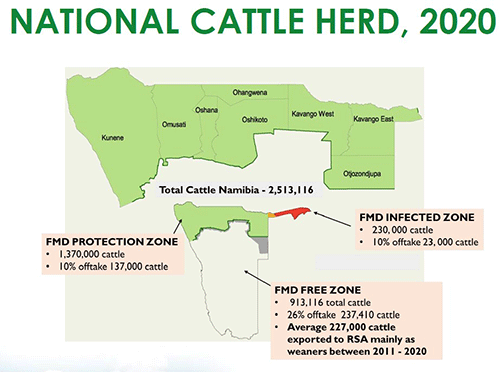Segregation of farmers in northern Namibia, through the veterinary cordon fence, compounded by poor marketing opportunities, grazing management, stock theft and lack of funding are but a few major challenges farmers in the Northern Communal Areas are grappling with.
Other challenges include the poor viability of abattoirs, which leads to uncompetitive market prices, climate change and the high cost of production.
Notoriously known as the ‘redline’, the VCF is a border between north and south, which is used as an animal disease control mechanism.
Its negative ramifications on northern Namibian farmers are highlighted in a study by the Namibia National Farmer Union (NNFU), which was presented at an agricultural indaba recently.
The study aimed to solicit support for struggling farmers in northern Namibia.
The report further points to an untapped potential for the NCAs market, a relatively large herd size finding itself in a huge informal market.
There are an estimated 1.5 million cattle in the NCAs.
Additionally, government institutions located in the NCAs have also been identified as potential clients for that market.
The study also called for the expansion of the Foot and Mouth Disease (FMD) free zone.
This, New Era understands, will enable NCAs that have not recorded FMD cases in decades to have access to the lucrative markets south of the redline and others such as South Africa and the European Union (EU).
“The creation of a new FMD-free zone will lead to increased cattle prices, which would eventually lead to increased revenue for farmers. The study also highlighted non-monetary benefits of creating an FMD-free zone, such as employment and new markets creation,” reads the report.
Namibia contains four zones (infected, buffer, surveillance, and free) for the purposes of FMD control.
“There is a need to improve NCA animal health status. Only then we shall genuinely unlock the NCA meat industry potential or else we shall continue looking for truly worthless markets,” reads one recommendation.
Bottlenecks
Poor road infrastructure, human wildlife conflicts and the presence of predators are also highlighted as chief stumbling blocks for farmers in the NCAs.
The NCA covers parts of the Kunene, Omusati, Oshana, Ohangwena, Oshikoto, Kavango West, Kavango East and Zambezi regions.
Interestingly, regions classified under the NCAs are rated “very high” in terms of food insecurity except for Zambezi, which is rated “moderate”.
Primarily, the redline seeks to control the spread of FMD.
Its critics, however, see it as draconian, repugnant and that it serves colonial interests.
Silver lining
While odds are stacked against them, farmers in the NCAs have forged ahead with efforts to turn their fortunes over the past two years, the study found.
In 2020, 27 auctions were conducted in the NCAs where 2 303 cattle were sold out of registered 2 529. Cattle prices averaged N$7 626 per head.
That year, the total turnover was N$17.5 million.
The following year, 28 auctions were held which saw 2 533 cattle registered. Only 2 310 cattle were eventually sold for roughly N$7 792 each, translating in a turnover of N$18.5 million.
So far this year, 29 auctions have already taken place in the NCAs. The picture looks slightly different with an increase in both number of cattle registered and sold at auctions.
In 2022, 3 216 cattle were registered, of which 2 806 were successfully sold at an average cost of N$7 832.
Despite the limited capacity and viability of abattoirs, statistics reveal further that 2 115 cattle and 73 goats were slaughtered at butcheries in the NCAs, resulting into a profit of N$22 million.
Last year, 2 719 cattle, 118 goats, three sheep and 472 pigs were slaughtered, resulting in a revenue of N$31.5 million.
This year alone, 2 710 cattle, 101 goats, 25 sheep and 401 pigs were slaughtered, generating N$27.8 million in the process.
To mitigate the hostile environment in which farmers operate, NNFU is pushing for the establishment of an abattoir association; a small stock market in Kunene, bush-to-feed initiative in Ohangwena and facilitating an auctioning and mentorship programme.
The University of Namibia, on the other hand, is conducting studies on the profitability of abattoirs, FMD causes and possible solutions and commodity-based trade.
“But this is not enough,” the report states.
Along with South Africa and Botswana, Namibia is one of the biggest beef exporters to the EU.


